The Mandevilla has many varieties, and all of these vining tropical flowers are showy and gorgeous. The Mandevilla vine, also known as the rock-trumpet, is gaining in popularity, and you can find them in stock at most garden centers throughout the United States.
The vigorous growth of the Mandevilla makes it an excellent addition to any summertime garden. Use the Mandevilla vine to bring some color to your gazebo, patio, or over doorways. The Mandevilla is a hardy plant, and it survives winter conditions without any hassle.
Mandevilla Quick Facts
| Quick Facts | Details |
|---|---|
| Scientific Name | Mandevilla spp. |
| Common Names | Mandevilla Vine, Rock-Trumpet |
| Plant Type | Tropical, perennial vine |
| Sunlight Requirements | Indirect sunlight, partial shade |
| Water Requirements | Keep soil consistently moist, but allow soil to dry out between watering sessions |
| Soil Type | Well-draining, loamy soil rich in nutrients like nitrogen and calcium |
| Fertilization | Slow-release fertilizer or organic compost after 6-12 months of growth |
| Pests | Aphids, Scale, Mealybugs, Red spider mites, Whiteflies |
| Deer Resistance | Unclear; anecdotal reports suggest some species may be deer-resistant, but others are not |
| Overwintering | Bring indoors when temperatures drop below 50°F; check for pests and trim back to a third of its size before bringing in |
| Blooming Season | Spring through fall |
| Companion Plants | Jasmine, Passionflower, Clematis, Bougainvillea, and climbing roses |
| Attracts | Hummingbirds |
| Uses | Pergolas, trellises, arches, large planters, and flower beds |
About Mandevilla Plants
The Mandevilla vine got its moniker from the late Henry Joseph Mandeville, a British diplomat, and avid gardener. Gardeners will instantly recognize the Mandevilla vine by its brilliant, trumpet-shaped flowers, oval leaves with a glossy texture, and its enthusiasm for climbing.
Mandevilla vines enhance the visual of arches, pergolas, and they do well as potted plants trellised on the patio. This plant loves to climb, and it will reach the top of any trellis or pergola with ease.
Mandevilla is a low-maintenance plant during the height of the growing season. The Mandevilla bursts into bloom in the springtime, lasting through to the fall. This plant is an ideal companion for other large planters, or in flowerbeds.
One of the best features of the Mandevilla is that it attracts hummingbirds to the garden. Relax on your patio on a hot summer afternoon, and watch the hummingbirds sip away at the flower’s nectar.
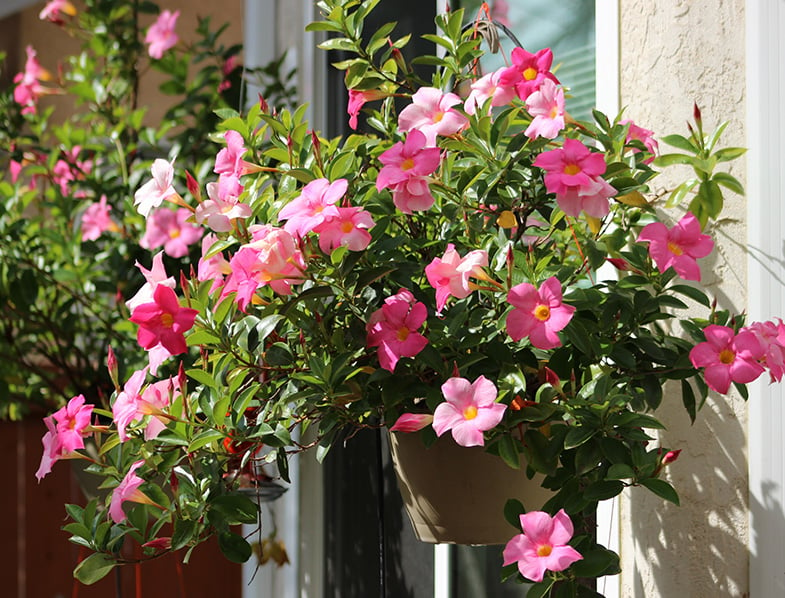
Growing Mandevilla
Mandevilla loves growing in tropical climates, with plenty of sunlight, rain, and well-draining soil. Select the right planting location in your garden and prepare the soil before planting.
Soil Type
Ideal soil for Mandevilla plants is well-draining, loamy soil that is rich in nutrients like nitrogen and calcium. Providing the right soil conditions ensures that the plant receives adequate nutrition and water for proper growth and flowering.
When growing Mandevillas in containers or pots, using a compost potting mix is a good choice. This mix offers the necessary nutrient balance and drainage that the plant requires. Additionally, mixing perlite into the soil mix can help with water retention, ensuring that the plant receives consistent moisture without waterlogging the roots.
Sunlight Requirements
Mandevilla flowers are a true show-stopper. The beautiful shape and eye-pleasing color of the flowers complement the foliage of the plant. To ensure that your Mandevilla bloom to full potential, make sure you plant them in an area of the garden that receives plenty of indirect sunlight throughout the day.
While it’s more than possible to grow Mandevilla in the full sunshine, they seem to do better when they have a bit of shade to cool off under on a hot day. Gardeners should note that if they don’t give the Mandevilla the sun it needs, then they can expect the plant to flower poorly during the growing season.
Planting your Mandevilla in an area of the garden that receives morning sun, but has some shelter during the peak midday sun hours, helps to enhance growth and flowering in your Mandevilla. Gardeners must also ensure they tie down the Mandevilla to prevent strong winds from shifting and damaging the plant.
- HARDINESS ZONE.10-11
- GROW.Mandevilla seeds require shallow planting, only covering them slightly with soil. Keep these moist and warm, about 65 to 75 degrees F. (18-24 C.), and place them in bright, indirect light. The seeds should germinate within a month or so.
- WHEN TO PLANT.Mid-to-late spring
- TALL.Grows up to 10-15 ft. tall (300-450 cm) and 3-5 ft. wide (90-150 cm).
- USE.The vigorous growth of the Mandevilla makes it an excellent addition to any summertime garden.Use the Mandevilla vine to bring some color to your gazebo, patio, or over doorways.
- HARDINESS ZONE.10-11
- GROW.Mandevilla seeds require shallow planting, only covering them slightly with soil. Keep these moist and warm, about 65 to 75 degrees F. (18-24 C.), and place them in bright, indirect light. The seeds should germinate within a month or so.
- WHEN TO PLANT.Mid-to-late spring
- USE.The vigorous growth of the Mandevilla makes it an excellent addition to any summertime garden.Use the Mandevilla vine to bring some color to your gazebo, patio, or over doorways.
- ATTRACTIVE.One of the best features of the Mandevilla is that it attracts hummingbirds to the garden. Relax on your patio on a hot summer afternoon, and watch the hummingbirds sip away at the flower’s nectar.
- HARDINESS ZONE.10-12
- GROW.Mandevilla seeds require shallow planting, only covering them slightly with soil. Keep these moist and warm, about 65 to 75 degrees F. (18-24 C.), and place them in bright, indirect light. The seeds should germinate within a month or so.
- WHEN TO PLANT.Spring
- TALL.Mandevilla sanderi is a shrub with a naturally bushy habit, 2–3 meters high, or 4.5 meters (15 feet) if the climate is warm.
- USE.Use them on trellis, fences, or other supports, let them spill outward over baskets, large pots, or plants, or give them a starring spot trained to an espalier frame.
Last update on 2024-09-21 / Affiliate links / Images from Amazon Product Advertising API
Watering and Drainage
The Mandevilla enjoys having its soil moist throughout the day. However, gardeners should allow the soil to dry out between watering sessions. The gardener can provide a slow trickle watering system that slowly releases water into the soil to ensure accurate moisture levels at all times.
The gardener must ensure the soil in the planting spot has adequate drainage.
- Mandeville doesn’t enjoy getting their roots wet in soggy soil, and it may result in the development of root rot that damages or kills the plant. When watering, spray down the leaves of the plant to remove any dust or debris on the leaves.
- Mandevilla requires well-drained soil that’s rich in nutrients like nitrogen and calcium. One of the most important parts of planting your Mandevilla is providing the right potting mix or substrate for the plants.
- Mandevilla likes loose and loamy soil that drains well and holds the right balance of nutrients to help the plant grow. Using a compost potting mix for Mandevilla growing in containers or pots provides the plant with a good base.
However, gardeners should place a layer of gravel at the bottom of the pot to improve soil drainage. Mixing some perlite into the soil mix helps with water retention.
Mandevilla Fertilizer
Mandevilla plants require fertilization after 6-12 months of growth. Gardeners should proceed cautiously when fertilizing, using a slow-release fertilizer product diluted with plenty of water. This approach helps avoid burning the plant’s root system, which can occur if too much fertilizer is applied.
Alternatively, providing the plant with a top dressing of organic compost can also supply the necessary nutrients for healthy growth and vibrant flowering. Gardeners should ensure that they do not over-fertilize their Mandevilla plants, as this can lead to root damage and poor growth.
When buying your Mandevilla at a garden center or nursery, the plant will likely have slow-releasing fertilizer mixed into the soil. The nutrients in the soil should last your Mandevilla a few months, but after it runs out, the gardener will need to add some more fertilizer to keep the plant growing.
Gardeners must ensure that they don’t add any additional fertilizer to the plant for at least 3 to 4-months after planting. The addition of fertilizer on top of the nutrients already in the soil results in burning the root system.
After the Mandevilla reaches 6 to 12-months old, the gardener can fertilize cautiously, using a slow-release fertilizer product diluted with plenty of water. Alternately, providing the plant with a top dressing of organic compost may give the plant the nutrition it needs to grow and flower.
What Are the Common Pests Affecting Mandevilla plants?
Some of the more common pests affecting Mandevilla are the following.
Ants bring aphids to plants that are weak or diseased. If you find aphids and ants crawling on your Mandevilla, blast them away with a strong jet of water from the hose. Alternatively, the gardener may apply an organic pesticide that kills the bugs.
For further protection of the plant, the gardener can spray it down with a light solution of Neem oil. Most pests find neem oil either toxic or repulsive, keeping your plants free from pests and disease.
Gardeners may also notice the presence of mealybugs collecting under the leaves of the Mandevilla. Mealybugs typically attack plants that aren’t getting enough water. Low humidity levels or a lack of watering in the summer may cause them to appear on your plants.
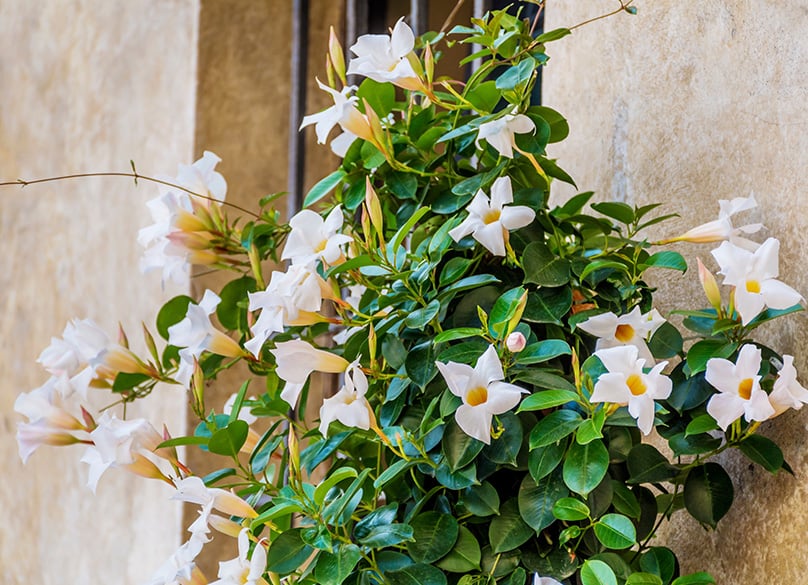
If the gardener notices the appearance of webbing on the plant, it’s a classic sign of spider mite infestation. Spider mites appear when climate conditions get too hot for the Mandevilla to handle. These pests are incredibly persistent, and gardeners will need to use an organic pesticide or neem oil solution to get rid of the bugs on their plants.
Gardeners should inspect their plants two to three times a week for signs of pests, and ensure that they check the plant thoroughly before the start of the winter season.
Overwintering Your Mandevilla
Mandevilla is a very hardy plant, and they can easily survive outside in the wintertime, in many U.S. states. As the winter season approaches, gardeners should check their Mandevilla for signs of pest, larvae, or eggs.
The gardener can then prune the plant, removing infested or diseased portions of the plant that might spread. If there is severe pest damage, then the gardener can treat the plant by spraying it with neem oil to kill the bugs.
Neem oil is a natural pesticide treatment that’s effective at killing the following pests affecting your Mandevilla.
Neem oil is safe to use, but it’s toxic if ingested, so keep it away from the reach of small children.

Mandevilla plants also have to deal with any forms of disease that show up during the growing season. It’s common for these diseases to cause the foliage to drop off of the plant, reduce flowering, and turn the foliage yellow.
In most cases, the growth of fungi is a sign that conditions are too humid or moist. The plat may also have a lack of ventilation at the planting site, resulting in the onset of powdery mildew. Gardeners must ensure that the soil dries out between waterings to prevent the onset of disease in the plant.
Prune the foliage to improve air circulation around the plant, and don’t worry if some leaves turn yellow and fall off of the Mandevilla, it’s a normal part of the growing cycle. It’s only when the plant experiences a sudden turn in the health of its foliage that there could be a possible problem related to care or pests affecting the plant.
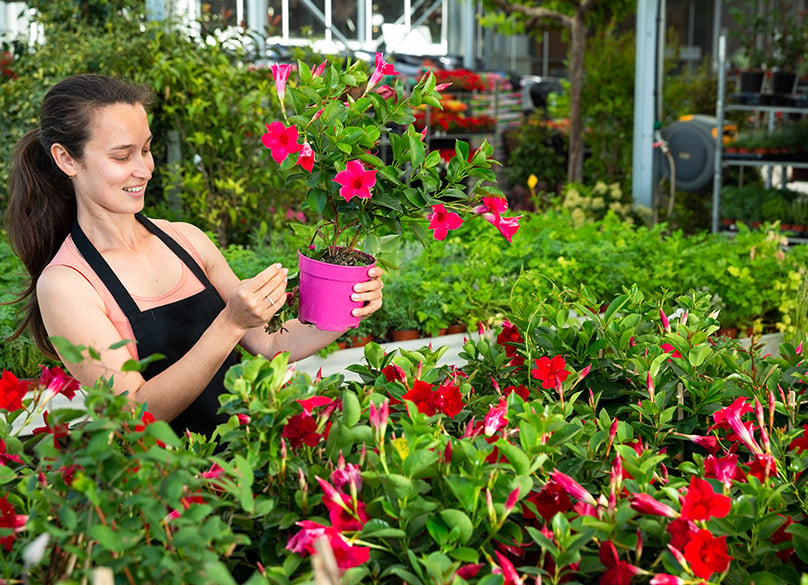
Do Deer Eat Mandevilla Plants?
The Mandevilla plant has no official guidelines online, stating whether the plant is resistant to deer feeding on it during the summer. However, according to anecdotal reports, some species of Mandevilla display deer-resistant characteristics, while others don’t.
It’s important to note that the Rutgers University New Jersey Agricultural Experiment Station deer resistant database, has no mention of Mandevilla being deer-resistant.
Growing Your Mandevilla All Year
The Mandevilla is a frost-tender perennial, even though most gardeners think of it as an annual plant. After the wintertime temperatures drop below 50 F, gardeners need to bring the Mandevilla indoors for the season.
Gardeners must ensure they check the plant for pests before bringing it indoors. The gardener can then cut the plant back to a third of its size, and place it in an area of your home that receives indirect sunlight during the day.
Only water the Mandevilla when the soil feels dry to the touch. As the springtime appears, and temperatures rise consistently above the 50F mark, gardeners can clean up the plant by removing any dead foliage, and then return it to the garden for the summer.
Conclusion
Mandevilla plants are a stunning and versatile addition to any garden, providing an abundance of vibrant, trumpet-shaped flowers and lush foliage. Their climbing nature makes them perfect for decorating pergolas, trellises, and arches, while their ability to attract hummingbirds adds an extra layer of charm to your outdoor space.
By understanding the plant’s sunlight, water, and soil requirements, as well as implementing proper care techniques such as fertilization and pest control, you can ensure a healthy and flourishing Mandevilla plant.
Although some care is necessary during the colder months, bringing the Mandevilla indoors for overwintering allows for year-round enjoyment of this captivating tropical vine.
Mandevilla FAQs
Do mandevilla plants come back every year?
Yes, Mandevilla plants are perennials, meaning they come back every year, though they are often treated as annuals in colder climates.
Does mandevilla like full sun or shade?
Mandevilla prefers a mix of sun and shade. Ideally, it should be planted in a location that receives morning sun and some shade during peak midday sun hours.
How do you take care of a mandevilla plant?
Care for a mandevilla plant involves providing well-draining, nutrient-rich soil, regular watering while allowing the soil to dry between sessions, and periodic fertilization. Protecting it from pests and overwintering indoors in colder climates are also important.
Does mandevilla survive winter?
Mandevilla can survive mild winters outdoors. However, in colder climates where temperatures drop below 50°F (10°C), it is recommended to bring the plant indoors to overwinter.
How do I save my mandevilla for next year?
To save your mandevilla for next year, prune it back, check for pests, and bring it indoors before the first frost. Place it in a location with indirect sunlight and water it only when the soil feels dry.
Will mandevilla bloom all year indoors?
Mandevilla may not bloom all year indoors, but it can continue to grow and maintain its foliage. It typically blooms from spring through fall when placed back outdoors.
Can you keep mandevilla as a houseplant?
Yes, you can keep mandevilla as a houseplant, especially during the winter months in colder climates. Ensure it receives indirect sunlight and proper watering while indoors.
How long do mandevilla plants last?
With proper care, mandevilla plants can last for several years, even though they are often treated as annuals in colder climates.
What is the lowest temperature a mandevilla can tolerate?
The lowest temperature a mandevilla can tolerate is around 50°F (10°C). It is recommended to bring the plant indoors for overwintering in colder climates where temperatures drop below this threshold.

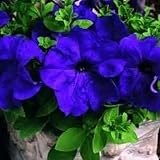
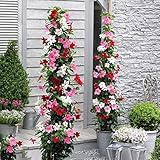
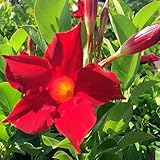
20 Comments
very helpful information
This was very helpful compared to the last site l was looking at! Thank you!
Our Mandevilla was doing great and flowering pink flowers. All of a sudden the leaves are turning yellow with some black and dark green spots and falling off. Is it diseased or am I watering too much? It’s about 3.5 ft tall and we’ve had it a couple of months in same sunny spot.
I have several mandeviila plants purchased directly from an Encinitas grower. One of them, growing in a pot has multiple blooms but the blooms have gotten very small. Any ideas about the cause/remedy for this?
I guess I’m confused. If it hardy anywhere in US why does it need to be taken inside when temp is below 50F? Can it be wrapped in a blanket or insulating wrap and left outside over the winder in zone 7b?
I found on another site hardy only to zone 9…I was also confused, hope this helps you…happy gardening!
My mandevilla has these long thick stems. Is this where the flowers bloom from.
How long does it take to start from seed.
My mandeville has not blossomed in 2 years very healthy lots of foliage lots if vines kept inside all winter put in deck during summer but no blossoms i do notice some very small blackish seeds that come and go any suggestions? I do fedd regularly shoukd i prune it?
What are you feeding it with? What formula?
My Mandeville plant is dropping leaves, the leaves develop a dark brown blotch in the center of the leaf then the blotch expands and spreads over the leaf resulting in the leaf dying. Any suggestion/reply would help,thanks
Hi I live in Perth Western Australia which is a Mediterranean climate but can you tell me how long Mandevilla live for as well as Mandevilla Touramaline. I have them in large pots all around my white picket fence and they are stunning with flowers all year round but obviously not so much during winter. I have just repotted them into larger pots as I have no garden as such because it’s all brick paved and artificial grass ie all for low maintenance purposes.
Thank you and I will await your response
Is it possible to start new plants off existing plant?
I live in zone 6a so I’ve brought my mandevilla inside. It is in a 12″ pot and continues to flower and is now even shooting out long vines. I plan to move it back outside into the ground in the spring. I would like to pinch it back to encourage bushyness but I don’t want to pinch off bud stems. Where do i start?
My mandivilla flowers are being eaten. The leaves are healthy looking. But the flowers have circular spots that look like something is eating it. Need oil hasn’t helped, The marks appear overnight and are visibly worse every morning. How to treat?
I just bought a Mandevilla , and it will be kept in the house all year around , because i live in a Condo, any suggestions
It’s not clear to me. Is this a perennial? I plan to plant it outside in the ground, I do not plan on digging it up and wintering it in doors. Will the plant die outside all winter in the ground? I live in southern Indiana.
No it is not a perennial in your climate. Yes. It will die. It is a tropical plant. 45 degrees is the lowest it can take (and it won’t be happy about it). If you can cut it back a bit, dig a decent root ball, pot it up and put it in a sunny window it will be much bigger for you next year than buying a new small plant. I put mine in a tall planter, rather than round, where it had plenty of room for roots to grow down. It was was more than twice the size the next summer.
I have 2 in hanging baskets that I left out during winter. We had a very hard freeze for 4-5 days. These beauties are blooming like crazy. I am going to plant them in the ground, if only I can decide the perfect spot. Good Luck
I learned so much from your Video. Thank you, i can’t wait to get a couple and get started. Thank you again.